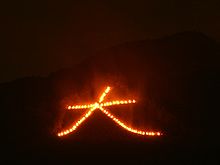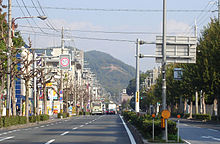- Gozan no Okuribi
-
Gozan no Okuribi (五山送り火), more commonly known as Daimonji (大文字), is a festival in Kyoto, Japan. It is the culmination of the O-Bon festival on August 16, in which five giant bonfires are lit on mountains surrounding the city. It signifies the moment when the spirits of deceased family members, who are said to visit this world during O-Bon, are believed to be returning to the spirit world—thus the name Okuribi (送り火) (roughly, "send-off fire").
The origins of the festival are obscure, but it is believed to be ancient. Specific families have the hereditary duty of organizing all the logistics of the bonfires, and they spend many hours annually providing volunteer labor to maintain this tradition.
Starting at 8 PM, the giant bonfires are lit, each with a distinctive shape. Three of the fires form giant Chinese characters, and two form familiar shapes. The characters, their locations, meanings, and the lighting times are:
- Daimonji (大文字), the character meaning "large" or "great:"
- on Daimonji-Yama/Higashi-Yama, Nyoigatake at 8:00PM
- Myō/Hō (妙・法), the characters meaning "wondrous dharma" (referring to Buddhist teachings):
- on Matsugasaki, Nishi-Yama/Higashi-Yama at 8:10PM
- Funagata (舟形), the shape of a boat:
- on Nishigamo, Funa-Yama at 8:15PM
- Hidari Daimonji (左大文字), again, the character meaning "large:"
- on Daihoku-San, Hidaridaimonji-San at 8:15PM
- Toriigata (鳥居形), the shape of a torii or shrine gate:
- on Toriimoto, Mandara-San at 8:20PM
The most famous—and the first to be lit—is the character dai (大), on Kyoto's Daimonji-yama (大文字山 daimonjiyama). The other four fires are lit at five to ten-minute intervals, and by 8:30, all the characters can be seen. Each bonfire lasts for 30 minutes.
The best place to view the festival is from the Nakagyo Ward, in the center of the city. Many hotels have Daimonji specials where, for a fee, you can see all five fires. Many people also like to go to the Kamo River, between Sanjo and Imadegawa Streets, for an excellent view of the initial fires.
Latitude and longitude
- Daimonji:35°1′23″N 135°48′14″E / 35.02306°N 135.80389°E
- Myō:35°3′21″N 135°46′32″E / 35.05583°N 135.77556°E
- Hō:35°3′17″N 135°47′10″E / 35.05472°N 135.78611°E
- Funagata:35°3′59″N 135°44′3″E / 35.06639°N 135.73417°E
- Hidari Daimonji:35°2′35.5″N 135°43′53″E / 35.043194°N 135.73139°E
- Toriigata:35°1′40″N 135°40′5″E / 35.02778°N 135.66806°E
Categories:- Kyoto
- Festivals in Japan
- Hill figures
- Geoglyphs
- Daimonji (大文字), the character meaning "large" or "great:"
Wikimedia Foundation. 2010.






